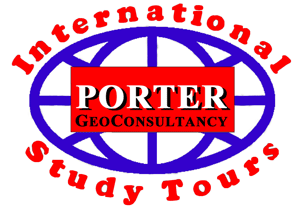| |||||||||||
| |||||||||||
| |||||||||||
 Diverse Range of Gold Deposits a Treat for Geologists
Diverse Range of Gold Deposits a Treat for Geologists
By Mike Porter
The day had been fairly typical for the members of the study tour group.
It was now early evening at 31 000 feet over southern Queensland, an hour and a half out of Charters Towers. The same time remained to run to the next destination, Orange in New South Wales. To starboard, the sky glowed from gold on the horizon, through pink, to the deep velvet blue of approaching night. To the east, the dark towering thunder-heads of the storm the pilot was skirting were punctuated by flashes of sheet lightning, while a large, crescent shaped bushfire front glowed a livid red through the shadow of night below. The nine passengers, experienced geologists from all around the world, had finished dinner and were recollecting their day. They had left Charters Towers early that morning by coach, to first visit the Mt Leyshon gold mine and then in the afternoon, under an hour away by bus, the Vera-Nancy operation at Pajingo. Both had been superb, with thorough, concise briefings, followed by a well planned open pit tour at Mt Leyshon, and a core display and underground inspection at Vera-Nancy. There had been ample time at each mine to take in all the key points. Take off from Charters Towers had been at 5:30 pm, after another one hours drive from Pajingo. The twin turbines of the fast, pressurised, Cessna Conquest aircraft were powering them south for the visit to Cadia next morning. From time to time the strobe lights of the second Conquest with the other nine of the eighteen participants on the tour could be glimpsed 5000 feet below, and a little to port. This was the close of the seventh day of the nine day AMF OzGold '97 International Study Tour of Australian gold deposits. Over the nine days, those taking the full tour would travel a total of 7000 km, starting in Perth and ending in Melbourne. Along the way they would have the unique opportunity of visiting twelve of the more significant gold deposits of Australia, in five states and territories. These deposits represented most of the diverse styles of gold mineralisation found to date within Australia, from the Archaean, through the Proterozoic to the Phanerozoic. The tour was available in two modules, with participants able to take either or both. Archaean Module
The tour had started in Perth on the evening of Tuesday 25th November with a context setting mini-seminar on "Archaean Geology and Gold in Australia".
The speakers, leaders in their fields, were Dr John Myers of the GSWA, Professor David Groves of the University of WA and Dr Charles Butt of the CRC LEME. Their presentations had respectively covered the "Tectonics and geological setting of the Australian Archaean cratons", the "Distribution and controls of Archaean gold mineralisation in Australia" and the "Behaviour of gold in the weathering profile". Next day commenced with a visit to the Boddington gold mine south-east of Perth, followed by an evening commercial flight to Kalgoorlie. On the following two days visits had been made to the KCGM Super Pit at Fimiston, the Kanowna Belle mine and the St Ives Complex, while a geological traverse was conducted across the greenstone belt to the south of Kalgoorlie, courtesy of the GSWA. These visits emphasised the contrasts and similarities between deposits in the same district, as well as their geological context. Each had been half day tours with less than an hours drive between. On the Friday evening, two of the South African tour participants gave a presentation to a joint meeting hosted by the AMF and the Kalgoorlie Branch of the AusIMM at the Hannan's Club. Next morning the group boarded the two charter aircraft for the first time to head north to the Bronzewing mine for the day and then on to Newman in the late afternoon where the Archaean Module ended. At Bronzewing, presentations were also given by staff from the Jundee and Nimary mines, illustrated by plans, sections and rock specimens. Several members left the tour at the end of the Archaean Module in Newman to take commercial flights back to Perth next day, while more were waiting to take their place for the second half of the tour, the Proterozoic-Phanerozoic Module. Proterozoic-Phanerozoic Module This module of the tour had been over-subscribed, with three left on the waiting list, unable to be accommodated. The module started with an early flight out of Newman for Telfer, and a late afternoon continuation to Halls Creek in the Kimberleys for the night. Next morning the group took-off at 5:30 am local time, diverting over the Wolf Creek impact crater, en route for The Granites in the Northern Territory, arriving just after 8:00 am Central Standard Time. Following a 30 minute drive to the Callie mine, a well managed half day visit ensued, before returning for a 1:15 pm take off from The Granites, and the one hour flight to Tennant Creek. At Tennant Creek there was insufficient time for a mine visit. Instead the group was given a geological briefing at the Mining Hall of Fame and a core display from drill holes through Tennant Creek mineralisation and country rocks. The 5:30 pm take off from Tenant Creek was timed to take advantage of a gap in the impending weather. The aircraft had been refuelled and a hot dinner taken on board for the three hour flight to Charters Towers. Despite the threatening weather, the air crew executed another smooth flight, a little longer than scheduled as they flew around the tropical storms brewing in the Gulf country. Half way through the flight the lights of Mt Isa could be seen to starboard, and the plume from the copper smelter just distinguished, caught by the last rays of the setting sun. Arrival at Charters Towers was on schedule at 9:30 pm. As at all of the other sites, a bus was patiently waiting to take the group to their motel and a rapid check-in. Next day involved Mt Leyshon in the morning, then with a cut lunch en route, on to Pajingo for the afternoon and back to Charters Towers for the evening flight south to Orange, again with dinner in the air. From Orange, the party took an early bus trip next morning to Cadia for a comprehensive series of briefings on both Cadia and Ridgeway, and a session in the core yard. In the mid afternoon the party returned to Orange and flew south to Bendigo for an evening tour of the geology and gold mineralisation of the Central Deborah Tourist mine. This clearly demonstrated the geology and style of mineralisation exploited in the Bendigo field. The underground tour was followed by a 'Crib Dinner', also underground, with an excellent buffet and choice wines from the Victorian gold fields. After the dinner had started, the second mini-seminar was commenced. The theme was "Proterozoic and Phanerozoic gold, with emphasis on Victoria". The speakers were Dr Neil Phillips of Great Central Mines who spoke on the "Geological setting and gold mineralisation of the Proterozoic and Phanerozoic of Australia", Tom Dickson of the Geological Survey of Victoria who addressed "The history, geology and potential of Victorian Gold", and a joint session by Doug Buerger and Garry Johansen of Bendigo Mining NL who spoke on the "Controls of gold in the Bendigo field and the problems of sampling coarse gold". Next morning involved an early drive to the Fosterville mine, for yet another very professional presentation followed by visits to several pits and study of primary ore in core. The group returned to Bendigo at lunch time for a break and late checkout before driving south to Melbourne where the module and tour ended at Tullamarine airport. The Participants While the tour itinerary was restricted to Australia, it warranted its title of 'International Study Tour' on the basis of the participants. They came from companies in North and South America, Europe, South-east Asia, Africa and Australia. A truly international and intercontinental gathering. This group represented a breadth of experience and backgrounds from across the world, producing a very interesting and high powered party that interacted well, both on a professional and social level, and with the geologists at the mines visited. Great Advert for the Gold Industry The tour presented a unique opportunity to visit representative examples of the diverse range of gold mineralisation styles and mines that have made Australia one of the worlds largest gold producers. It encapsulated the whole Australian gold industry. In addition it was, as an exploration manager from a large African mining house commented, "a great advertisement for the Australian minerals industry", emphasising just what our gold industry has achieved. Superb Mine Visits The tour was also a great advertisement for the calibre of geologists employed in the Australian minerals industry. Virtually all of the visits on the tour were outstanding, with concise, thorough and pertinent briefings, followed by underground or open pit visits and core displays as appropriate, commonly accompanied by fruitful discussion and interchanges of experience. In quite a few of the mines the group was split into two nine man teams, with one going to the mine, the other to a core display, before swapping. In other cases one team visited the open pit while the other went underground, again subsequently swapping. Special thanks go to David Burton of Worsley Alumina at Boddington; Roger Bateman, Andrew Pardey and Mark Cherry at KCGM in Kalgoorlie; Matt Daley and Sam Beckett at Kanowna Belle; Bob Watchorn, Byron Dumpleton and the WMC Resources team at St Ives; Stephen Wyche of the GSWA; Ian Blucher and the Great Central Mines staff at Bronzewing, Jundee and Nimary; Graham Howard and his team from Newcrest at Telfer; Andy Purvis and the North Flinders Mines staff at Callie; Nick Byrne and Peter Simpson of Giants Reef Mining at Tennant Creek; John Campbell of Mt Leyshon Gold Mines at Mt Leyshon; Dave Hall and his associates of the Pajingo Joint Venture at Pajingo; Ian Tedder, Paul Dunham and the Newcrest staff at Cadia; and Trevor Jackson of Perseverance Exploration at Fosterville. We are also deeply appreciative of the response of the various companies who had no hesitation in allowing the visits and offering the valuable time of their staff. We hope that the exchanges and discussion with the tour group in part repaid their generosity. The other essential ingredients of the tour were the two well maintained aircraft and the careful professionalism of Mike and Leigh O'Connor of O'Connor Air Services from Mt Gambier. | |||||||||||











